 |
|
En alianza con el Padre Kentenich, sus hijos espirituales hacen suyo lo que lo movilizó a él el 31 de mayo In covenant with Father Kentenich, his spiritual sons and daughters make their own what moved him the 31st oif May Im Bündnis mit Pater Kentenich machen seine geistlichen Söhne und Töchter sich sein Anliegen vom 31. Mai zu eigen |
|
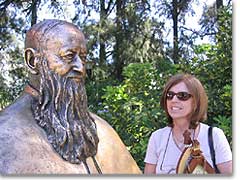 |
|
Padre, tu herencia nuestra misión... Father, your heritage, our mission... Vater, dein Erbe ist unsere Sendung… Fotos: Crivelli © 2005 |
|
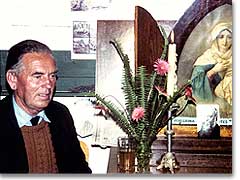 |
|
Don Joao, peregrino y misionera de la Mater John Pozzobon, pilgrim and missionary of the MTA Joao Pozzobon, Pilger und Missionar der MTA |
|
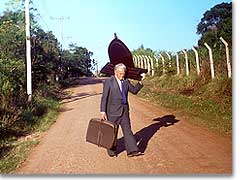 |
|
Mientras la Iglesia silenciaba al Fundador de Schoenstatt, don Joao llevaba a María al mundo y lo hacía así presente al Fundador While the Church silenced the Founder of Schoenstatt, John carried Mary to the world and in this way he made the Founder present Während die Kirche den Gründer Schönstatts zum Schweigen brachte, trug Joao Pozzobon Maria in die Welt und machte dabei den Gründer gegenwärtig |
|
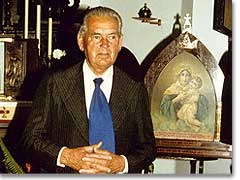 |
|
Vinculado al Santuario Original Deeply attached to the Original Shrine Tief verbunden mit dem Urheiligtum Fotos: Arendes © 2005 |
|
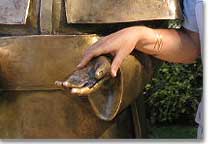 |
|
Si, Padre, vamos contigo Yes Father, we go with you Ja, Vater, wir gehen mit Foto: Crivelli © 2005 |
|
|
There are many ways to celebrate. study, understand and to live what the "31st of May", the third milestone in Schoenstatt, means. Feast of the Visitation of Mary in almost all the countries of the world, also mark a key event in Schoenstatt history and its founder,relative to the development of the Covenant of Love, and the relationship with the Church and society. With the "31st of May", Father Kentenich placed all the richness that grown in Schoenstatt at the disposal of the Church; with his prophetic charisma he anticipated the pastoral challenges and the pedagogy of faith and of life, which he wanted to call upon as a response through an organic thinking, loving and living; a response that the Church could not assimilate nor understand. It was left as a task for the spiritual children of the Father and Founder, in covenant with him, to make ,what he mobilized with the 31st of May, their own.
In the following article, Father Guillermo Carmona shows how John Pozzobon, the initiator of the Rosary Campaign, one of the outstanding fruits of the 31st of May, lived and functionally embodied the 31st of May. Almost 20 years since his death - the 27th of June of 1985 - the "poor, pilgrim deacon" John continues to light the way for us, as the Cyrenian of the Father.
Father Guillermo Carmona. We sense that the Campaign is a great contribution to the 31st of May. We are interested in knowing if its initiator - John Pozzobon - had an attachment to the 31st of May and how the Campaign contributed to it.
We could formulate the question that we have in this way: Is the Campaign a genuine fulfillment of the 31st of May?
1. Brief description of the 31st of May
The 31st of May, the Father and Founder defended the Schoenstatt world in a symbolic act - especially the organism of attachments - before the criticism of the Auxiliary Bishop of the Diocese of Trier, Germany, affirming that the pedagogical and psychological vision of Schoenstatt is Catholic, correct and responds to the challenges of modern times.
At the same time, he invited the Schoenstatt Family, represented in Bellavista, Chile to struggle for a mission, considering this essential for the future of Schoenstatt, the Church, and the world.
Elements to understand:
- Organic mentality versus a mechanistic mentality
- Psychology and pedagogy of the primary and secondary causes, and their mutual relationship, with its enormous consequence for the personality and development of the natural organism and supernatural attachments.
- Two neuralogical points for building the organism of attachments are:
- the organic marian devotion
- the father image and its interrelation with the paternity of God
Consequences
- The 31st of May is a mission: "crusade"
- It is lived in the Capital of Grace
- It is about the embodiment of the organism of attachments
- Since the experience of the 31st of May a "circulation of blood of the Family" and a "return flow" (from the Shrines)
- The 31st of May has a purpose: to make a contribution to the Church and the world
John Pozzobon and the 31st of May
We have the sense that John grew in a process whose fruit was the functional and many cases conscious living of - the 31st of May. There is a marvelous, historic coincidence in this: while the Father and Founder launched the crusade in 1949, John vitally assumes it in 1950.
Therefore, we should distinguish two aspects:
2.1 John's conscience in regards to the 31st of May
For the purpose of illustrating this point, Father Esteban Uriburu stressed the following testimonies:
1. In a letter to Father Kentenich on October 12, 1963 (10-12-63) John wrote:
"What gives me the most life and encouragement is to recall the happy date of 10-18-14, and then all the other dates. Poor John wants to to do everything to enrich the founding dates:.
2. To enrich the origin
On the 22nd of March of 1968 "even in the dark hours of dawn", Brother Germano Arendes departed for Schoenstatt, Germany, carrying two small Pilgrim MTA's, "to enrich the origin", writes John.
3. On the 26th of August ( of 1968) Pozzobon received a letter from Brother Arendes, telling him of the arrival of the two small Pilgrim MTA,s at Schoenstatt, and of the the encounter he had with Father Kentenich during which "he was happy and moved" to hear about Pozzobon. And now John is excited to know about this: "John truly felt Father Kentenich's spirituality, of the 31st of May. John cried a lot, understanding that all this was a return of the 31st of May to the original source. The two little shrines carried this return. That is how John understood and cried for feeling it more in profoundly, and almost unable to support it. Oh, beloved Mother, today you united John's poor heart very well with that of the
Father and Founder".
4. I know this from oral reports. Brother Germano Arendes had spoken to Pozzobon about the 31st of May. A few day later, he invited Brother Arendes to go on pilgrimage with him to all the tabernacles in the city of Santa Maria, on a pilgrimage of bread and water. And at each tabernacle,Pozzobon left a rose close to the Blessed Sacrament. While he was on pilgrimage, he was praying the rosary.
2.2 The 31st of May "functionally" lived by John
We can discover this reality in three places:
- in the testimony of his life and his writings
- especially, in his testament
- in his drawings (symbolism)
First Thesis
John has lived the three neuralgic points of the 31st of May
- the organic attachment to Mary
- natural and supernatural
- the social and the human
- the personal and profound attachment to the Founding Father. This in difficult times, when the Father was in exile. He remained firm and loyal in his identity.While the Church silenced the Founder of Schoenstatt, John carried Mary to the world and in this way he made the Founder present
Second Thesis
John has lived the organism of attachments in an exemplary manner. The Campaign permits a broad and full experience of the organism of attachments.
Third Thesis:
John and his work (the Campaign) have all the traits of the mission, of a holy crusade and of universal character. John affirms: "Living this spirit with the great grace that urged me to reach 32 years of the Campaign and 30 years of consecration, for the great Work of Schoenstatt. Eternal gratitude for the grace of loyalty: from my nothingness, she used me as a small instrument, and grace acted strongly. She never abandoned me at any moment of the Campaign. That is why I went on adding up the great walk of 32 years of the Campaign and of pilgrimage: 32 years, 382 months, 276,480 hours deposited in the Captial of Grace. All for the grandiose Schoenstatt Work, for the good of the Holy Church". "Schoenstatt brought a great change, a great enrichment to my faith, and also a mission to fulfill, a great apostolate...I started the Campagin when I found Schoenstatt, and there I new life, a different life began".
(Source: Pensamientos, N. 99, 69).
Fourth Thesis:
John has experienced the contribution of the Campaign for the original Schoenstatt and in virtue of this he has contributed to the "exchange of curculation and of the countercurrent". He was very attached to the Original Shrine.
Fifth Thesis:
John conceived the Campaign as an original contribution of Schoenstatt for the Church and the world.
In his words: "All for the grandiose Schoenstatt Work, for the good of the Holy Church".
"I repeat the words I spoke to the pilgrims from Argentina in the Shrine at Santa Maria: that I am with you and I give my life for the sake of this Campaign so that , from its powerful beginning here it may become a worldwide Campaign. And I do not in any way take back these words now.
(Hero TodayNot Tomorrow, by Esteban J. Uriburu, p. 97) (New Schoenstatt, 15th of June of 1985, twelve days before his death).
"When everything seems useless to us, others will follow this grandiose work of worldwide salvation. Our thirty years (of Campaign) are just a great beginning. That is why we cannot run from the cross, so that the fruits will mature at their given time".
(Source: Pensamientos N 99, 52/53)
Translation: Celina M. Garza, Harlingen, Texas, USA